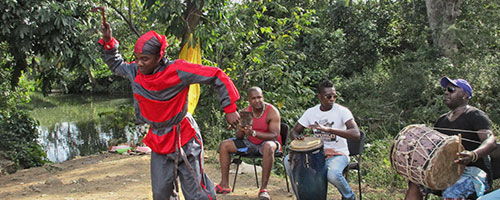Palmira
May 21 – May 28, 2017
Afro-Cuban Cultures and Religions: Palmira
May 21 – May 28, 2017
Palmira
In the 19th century, Las Villas province (today Cienfuegos) was one of the major centers of Lucumí culture and religion in Cuba. Commonly known as “Santería,” the Lucumí religion has historical roots among the Yoruba and Bantu people of Africa who were brought to Cuba as slaves. Havana and Matanzas were ports of entry, but because most of the sugar plantations and mills were located around Cienfuegos, thousands of Africans made their way south, bringing their culture and religion with them. When slavery was abolished in the 1880s, many of the former slaves remained in small towns like Palmira where they founded religious associations as a way to preserve their cultural heritage.
Today, four of them remain in Palmira: the Sociedades de El Cristo, Santa Bárbara, San Roque and Casino de los Congos “San Antonio de Padua.” In addition to being religious centers, they have functioned without interruption for more than 100 years as mutual aid societies and community centers. They have gained international recognition as centers of traditional Lucumí culture. They are also associated in popular culture with the names of famous Cuban musicians like Beny Moré, the Orquesta Aragón, and Adalberto Alvarez, and have attracted the attention of important Afro-Cuban scholars like Natalia Bolívar and Rogelio Martínez Furé.
The names of these Lucumí associations reflect the socio-cultural phenomenon known as religious syncretism. They were founded under the auspices of local parishes, taking the name of a saint as a compromise with Catholicism, to reduce racially-based anxiety about the nature of these Afro-Cuban brotherhoods. Each saint was syncretized with an orisha, in an effort to blend social customs of European and African origins. We’ll learn about the historical roots of religious syncretism in Cuba and also hear from Lucumí practitioners what it means to them personally.
Many scholars believe that the way the religion is practiced today in small town in the provinces is a key to understanding the history and development of the religion in Cuba in general. They are studying the connection between lineages from Havana, Matanzas, and Cienfuegos, and tracing the idiosyncratic character of different practices to key figures in Lucumí history. While large cities like Havana and Matanzas experienced a greater influx of foreigners and felt greater pressure to conform to social changes, small towns in the provinces were largely ignored by outsiders and saw less migration. The religious associations in Palmira have remained in the hands of the same families for multiple generations, giving them a kind of stability and permanence not found in many other parts of Cuba.
